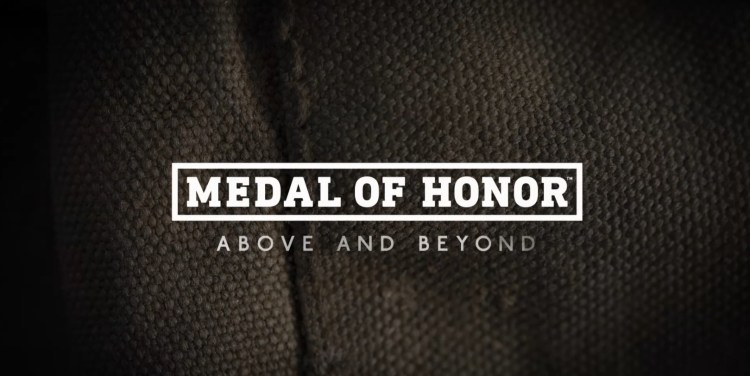Three years ago, Respawn Entertainment began making a new Medal of Honor first-person shooter set in World War II. The team included developers who had worked on the original video game nearly two decades earlier, and they wanted to bring it back. And thanks to a couple of deals, Medal of Honor is coming back as an exclusive 2020 virtual reality title for the Oculus Rift and Rift S, dubbed Medal of Honor: Above and Beyond. It’s a beefy game with more than 50 levels, which means it will have as much single-player gameplay as many standard console video games. It will also have multiplayer gaming.
I heard the story of how this happened in a group press interview with Peter Hirschmann, the director on the project for Respawn, and Michael Doran, executive producer at Oculus.
First, Doran, who previously worked with Respawn at EA, pitched Respawn on doing a game for the Rift. They went along and then EA bought Respawn. The project still went forward, and now there are 180 people working on it, making it perhaps the most ambitious VR project ever. We played part of the game at a demo event and then asked questions.
Here’s an edited transcript of our group interview.
June 5th: The AI Audit in NYC
Join us next week in NYC to engage with top executive leaders, delving into strategies for auditing AI models to ensure fairness, optimal performance, and ethical compliance across diverse organizations. Secure your attendance for this exclusive invite-only event.

Above: Michael Doran of Oculus and Peter Hirschmann of Respawn Entertainment.
Question: I wanted to understand the development timeline. You said you were working on the game, and then Oculus came calling?
Hirschmann: Probably three years ago, Respawn was still independent, but we had a very close relationship with EA. They had done Titanfall and Titanfall 2. We were doing Star Wars with them. An opportunity came along where, well, this is something we wanted to do, but would it be at Respawn?
Again, my history goes back to the very first project. Vince [Zampella, Respawn CEO] and a lot of the core Respawn guys worked on Allied Assault. It was honestly an emotional connection. It’s not like, “Wow, WWII is super hot, let’s go do that.” This was something that a lot of us started our careers doing. I worked at LucasArts for a number of years, so I had been laser sword and hyperdrive stuff. Vince and his team had been doing a lot of modern warfare stuff, and then Titanfall. It felt like there was an opportunity to go back and revisit it.
Question: What was the original plan in terms of platforms?
Hirschmann: It was a crazy time. It was literally a couple of months of just kicking around some ideas. Wouldn’t it be neat to go back? Oculus had been knocking on Respawn’s door for a while. An opportunity had never aligned. It was literally a conference call between Mike, me, and Vince in Vince’s office. Mike said, “Oculus is serious about stepping up the level of software. The way to sell hardware is with triple-A games.”
Again, this is two and a half years ago. We said, “Yeah, that’s great.” We had a lot of Rift fans in the building. But we felt like — you say you want triple-A, but do you really know what that means? That’s years of work. It’s not just the budget. It’s years of time. It takes a long time to make one of these, and the scope and the team size. That wasn’t what we were seeing on the platform at the time.
They said, “No, we’re serious.” I went up to Menlo Park with this pitch and pitched this game. It sounds like such a cliche, but I wanted to throw out the craziest idea possible and see what happened. They bought it in the room, so to speak. “Yeah, let’s do this.” Well, holy shit.
We got to work on it right away. To pre-empt the obvious question, the relationship trailer that was at OC4, it ended with 2019. That was a typo. We just slipped on the keyboard. [laughs] We moved the date just a few months after that, because we had done — we could see what the platform could do. Oculus saw what we were up to. “Let’s make this bigger and expand it.”
I give so much credit to Oculus for stepping up. We’re part of this next generation of software that’s hopefully helping define what triple-A in VR means. There’s some other great stuff coming as well. We’ve been working on it for a while. At its peak, around the world, we added it up, and there are more than 180 people working on this title. It has to be one of the bigger VR games ever put together. Just building it piece by piece. It’s been great.
To be able to show it and reveal it is wonderful. But it’s been a crazy couple of years, and we still have a little ways to go.
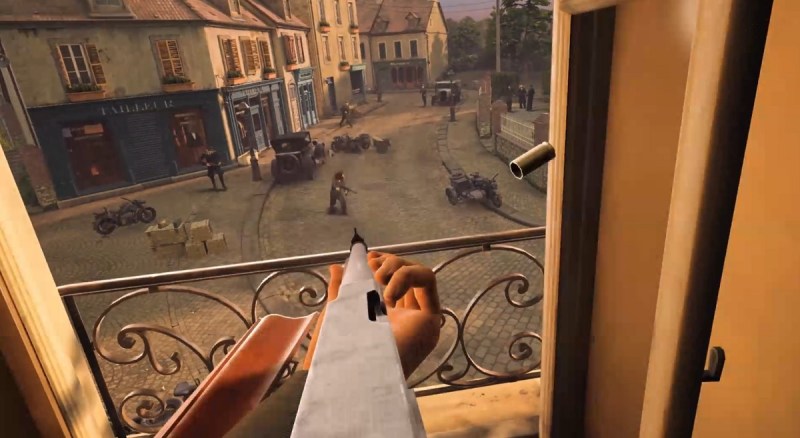
Above: The opening mission of Medal of Honor: Above and Beyond. You are in the French Resistance.
Question: You have a lot of things you gain in VR, but you also have these tradeoffs in graphical quality compared to what you can do on a high-end PC. Just looking at it, there are tradeoffs in physics, just how sharp everything looks.
The game’s pretty high-resolution. Again, one of the great things the platform allows is letting us really crank up the level of detail. When you lean in, you see the stitches on a uniform, the binding on a book, the grain in wood. We don’t dial any of that back.
We run at 90 frames per second, too, to prevent motion sickness. That’s a testament to the art team, that they’ve been able to build this level of fidelity with that performance. But I think you’ll see that the physics are pretty spot-on. When you throw a grenade, it has to act the way you think it will. When guys are blown through the air, stuff breaking apart, it has to feel authentic. We’re not downgrading any of that at all. I’m looking forward to everyone getting in there and seeing it in glorious stereo high-res.
Michael Doran: I worked at EA for 13 years, mostly with EA Partners. I worked on Battlefield from its inception through the acquisition of DICE. I never thought I’d get to work on a Medal of Honor game, because there was this friendly not-so-friendly rivalry between Battlefield and Medal of Honor back in those days.
Peter Hirschmann: It’s all one-sided.
Doran: But now it’s all one big happy family. The last project I produced was Titanfall. That’s where I met a lot of the Respawn folks. I had a great experience working on that with them. When I left EA I thought I would probably not work on another Respawn shooter, but Oculus had the right time, the right opportunity. We caught Respawn at the right time, and it’s been a dream to not only get involved with Respawn again, but to get to play in the Medal of Honor sandbox as well.
[Editor’s note: The initial conversation ended here. Then we played the game, and reconvened afterward for a Q&A].
Hirschmann: Did you have fun? That’s the number one goal here.
Question: Yeah, it was good. Do you recommend people actually try to aim down the sights?
Hirschmann: Everyone’s different. Over time, people get into the rhythm of holding with two hands, getting that stability bonus. Then it depends on the weapon. Over time — the Thompson I’m usually hip-firing, or the MP40. Hopefully you got a taste of that. Over the last couple of years we’ve put in a lot of resources and time to make the weapons system feel as natural and intuitive as possible. Those of you who’ve been playing VR for a long time — it’s tricky to get that to feel right. We try to give every weapon — not just every class, but every weapon itself — its own individual character.
For me, the big example is the Colt and the Thompson are really great weapons in the Allied arsenal, but when the magazine’s empty you have to eject it, pull out a new one, put it in, and charge the weapon. When you fire the M1 Garand, bang-bang-bang-ping!, it ejects the clip, and all you have to do is slap a new one in. Hopefully the player at home will learn, “Okay, that’s why our guys loved the Garand.” But over time the Germans figured out that when you hear that ping, the guy shooting at you is out of ammo.
We have a whole set of logic hooks where when the players use the M1, that ping announces the clip ejecting, they’ll hear it, and they’ll say in German, “Hear that?” They’ll leave cover and charge you. No matter what’s going on, if you’re reloading that M1 or pulling a pistol or grabbing something else, you’re vulnerable for a moment. That’s what guys went through back in the war.
Those kinds of moments are subtle, but again, it goes to that authenticity that we’re trying to get to. VR and the Rift allow us to do that in a way that we never could before with a traditional console game. The physical act of having to load that clip or that magazine is part of the experience. Hopefully that makes it more fun.
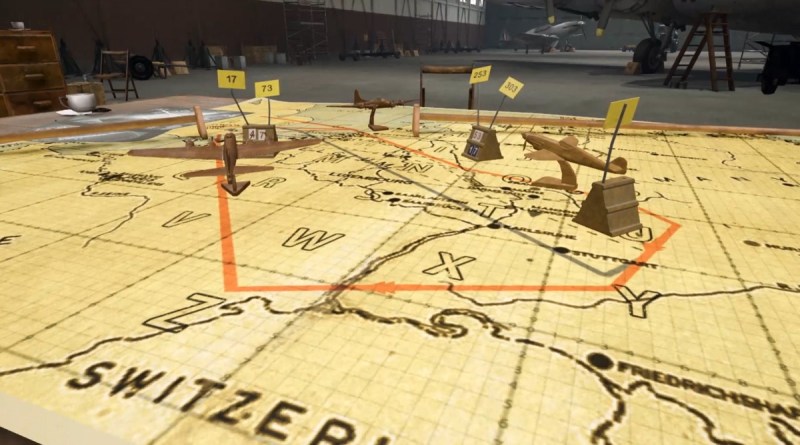
Above: VR finally goes to World War II with Medal of Honor: Above and Beyond.
Question: Will this be desktop only?
Hirschmann: Rift only, Rift all the way. We love the Rift. Rift and Rift S.
Question: Are there any other Medal of Honor games coming out on any other platforms?
Hirschmann: One game at a time. [laughs] Medal of Honor, 24/7.
Question: Does that push Titanfall 3 out further?
Hirschmann: [laughs] Yes, it puts Titanfall 3 further out. For a lot of us — again, I said this before. This is such a great day to be able to show it. We’ve been, pardon the expression, hunkered down on it for a couple of years now. To even say Medal of Honor out loud is kind of nutty. Project Rocket is the code name we used with outside parties. This is an exclusive, all-encompassing effort.
Question: Is it only single-player?
Doran: We do have multiplayer. We’re not really talking about it yet. We’re focusing on working with Dale and bringing Medal of Honor back. More to come on that. It will be ready at launch.
Hirschmann: Institutionally, we have some of the best multiplayer designers in the industry. I’m biased a bit. But from the Call of Duty days at Infinity Ward to Titanfall, some of those folks are on our team.
Question: I found the turn a bit abrupt and disorienting, how you can turn your body around. What kind of problems did you overcome or other options did you have with that?
Hirschmann: We allow you, in the comfort menu, to adjust that. It can be the instant flick. It can be much more gradual. We contextualize all those comfort options. We actually add a narrative context to all the comfort options. At the beginning of the game you go to the nurse’s office and basically do a physical. Are you left-handed or right-handed? Does this make you nauseous? Do you get motion sickness?
What we’ve learned over the last couple of years is that every player is different. There’s no profile that fits every person. Something that makes someone queasy doesn’t bother another person, but something else will. We’re trying to build as many individualized options as possible. There’s only a handful in right now, but we’re constantly adding more. From the vignettes to — anything you can think of, we try to find a way to put a hook in it.
Doran: Vibration, movement speed. There’s all kinds of stuff. It’s all about optionality.
Hirschmann: There’s even a “skip intense sequences.” For the levels where you’re on the motorcycle or skiing down a mountain, if that’s something you just don’t think you can handle, we’ll let you skip that. There will be a narrative beat. “You made it down.” The narrative keeps moving forward.
VR legs is a real thing. The more time you spend in the headset, the more comfortable you get, the more your brain adapts. For all of us on the dev team, it’s always important that we’re constantly running people from the company, from Respawn, through the game to see them play it.

Above: You can catch a grenade in Medal of Honor: Above and Beyond by holding up your arm.
Question: I was almost deceived into thinking that my hands were actually vibrating. When I was shooting, I could see this happening, but there’s no motion feedback, right?
Doran: There is haptic feedback in the controller, actually.
Hirschmann: We’re trying to make it as authentic as possible.
Question: You mentioned earlier on that you used some of the characters from the original games. Even from the first trailer, it seemed very familiar. Are you using locations from the previous games?
Hirschmann: Yes. Dubuisson, which is the town that was featured prominently in the first three games, plays a big part. Again, I’m very proud that as a franchise — our second Medal of Honor game, Underground, featured a woman protagonist. You played as Manon, who’s the leader of the French resistance cell. You played her the whole game, and that was a PlayStation game.
We’ve always tried to tell the complete story. Even at the highest level, acknowledging that it was an allied effort. We always highlight the British contribution, the Battle of Britain. It’s not just America, rah rah rah. The story of the war is so big that you can only focus on one little slice at a time, but highlighting that it’s an allied effort, and especially the French resistance — they’re some of the bravest people that fought in the war.
Your country is taken over and occupied, you have three choices: surrender, collaborate, or resist. The people that resisted, the courage to do that, where you’re not only fighting Germany, but your neighbor is going to turn you in if they think it’ll give them an advantage — that’s something we try to build in to the narrative, especially in the first part of the game. To be in the resistance was to live in a constant state of fear and paranoia. The Germans are after you. Collaborators are after you. You don’t know who else is in the resistance. The cell structure keeps that knowledge contained. Some of the most dangerous things the resistance members would do — if they ever had to make contact with another cell, they were immediately under suspicion.
We have a level in the game where you have to do that. It’s a mission based directly on one of the interviews we did with someone who fought in the resistance. She said the scariest thing that ever happened to her was, she was delivering a message to another cell. They captured her on the road thinking that she was a spy from the Gestapo, because she had information that she shouldn’t have had. They put her up against a wall and were about to shoot her until she was able to convince them she was on their side.
So we have a level where you have to make contact with another cell and they ambush you. They pop up and say, “Drop your weapons. Put your hands up.” That’s something you can do in VR. You actually have to drop your weapon and put your hands up, because we can measure the gestures you’re making. It’s a great scary moment in VR. You’re standing there like this and they have their weapons pointed at you and they’re interrogating you. “Who are you? Why are you here?”
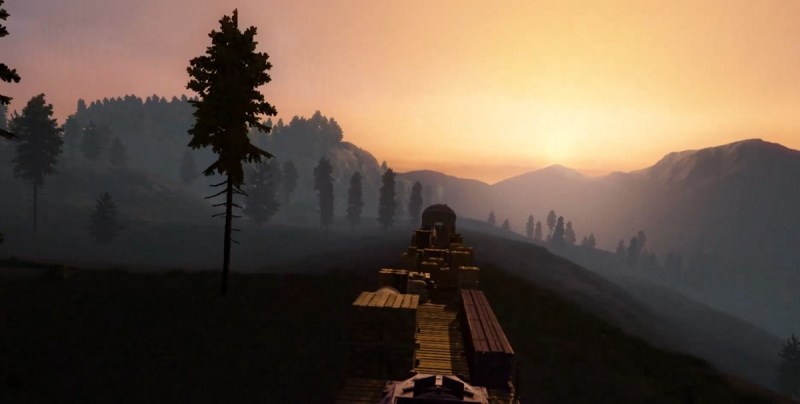
Above: You play an OSS operative in Medal of Honor: Above and Beyond.
Question: If you don’t do that, can you get shot?
Hirschmann: Yep. What’s the right way to put it? It’s a fulfilling payoff. If you think you can just screw around, they’re not going to mess around. Stuff that, we’re constantly looking to implement. Again, there are no quick time events, no “Press X for this.” We try to build as much natural human movement into the activities as we can.
Just the act of letting go of the weapon and throwing up your hands — you’re making yourself vulnerable. If you go for your weapon, we’re able to track — when we were prototyping our gesture system, we actually had a Simon Says game, where the AI would just randomly run through animations, and you had to respond. It was just a silly little designer game, but it was cool. You had to match what they were doing, and the system could track that.
Question: You mentioned the motorcycle mission. Are there driveable vehicles?
Hirschmann: Rideable. You’re on the back of the motorcycle shooting Nazis, and then you leap onto the train. We have a B-17 where you’re a passenger.
What I love about the B-17, a lot of games have put you in a bomber, but you actually get to walk around here, look out the window. At one point you’re hit by flak and the engine catches on fire. I think we showed that in the trailer. That’s some of my favorite stuff. You can see a B-17 in a museum. I paid $300 a couple years ago to take a flight in one. It’s an amazing experience. But there aren’t combat missions flown over Europe anymore, thank God. To be able to put the player in that situation, where the crew is arming the .50 cals and the flak is blowing up around you, enemy fighters are coming in, over planes are getting hit — it’s very easy to lose yourself in that.
It’s a game, but it gives you maybe a little insight into what it must have been like. Those bomber missions, you had to fly 25 of them before you could go home. Imagine the scariest flight of your life and people are shooting at you. You somehow through the grace of God survive, and then you have to do it again and again. That’s one of the little slices of the war that we wanted to tell. Getting to experience that with the crew and see how the react.
Question: How did you choose some of these missions? Battlefield V has some similar elements, like the resistance and the Norway mission.
Hirschmann: There’s a finite amount of WWII history. We get kind of meta about the Norway one, because the Nynorsk hydro plant, outside Rjukan in Norway, that’s where they did the heavy water research. The SOE, the OSS, the RAF, the Norwegian resistance, they were constantly sabotaging and blowing it up, and then the Germans would get it back online. We leaned into that. The Allies keep attacking this and the Germans keep getting it online.
In ours, the timeline is near the end of the war. You’re going in and blowing it up one last time. We did it first, actually. We had a heavy water mission in the original Medal of Honor, which took place earlier in the war. Battlefield V actually followed us.
There are certain touch points in the WWII story that we wanted to revisit, mainly because we’d done them in earlier Medal of Honor games. The platform opened up a fresh way to approach it. But just the fact that we’re doing VR wasn’t enough. To just replay Allied Assault’s D-Day level on the Rift would be cool, but it’s not enough.
In our game, you’re a combat engineer who’s recruited into the OSS. Combat engineers had a very specific job on D-Day. They had to blow the obstacles and clear a path for the armor to land. We do a whole setup where you’re in the OSS. You know the invasion’s coming. Your former engineer unit’s going in with the first wave. Engineers were the first ones on the beach. The OSS won’t let you go. “You’re a trained operative now. We won’t send you into a meat grinder.”
Our D-Day mission actually starts in a very unexpected way. You’re being told you can’t go, and you find a way to break loose of your OSS shackles and find out where your unit’s deploying from, steal a jeep, and do all this in way where….
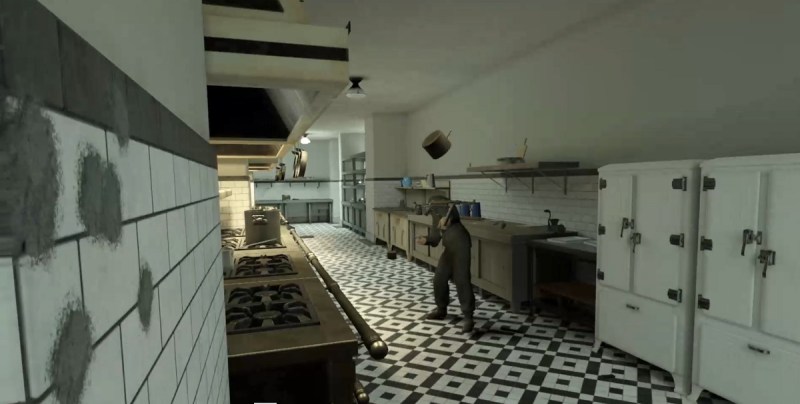
Above: Yes, you can throw a pot at a Nazi in Medal of Honor: Above and Beyond.
Question: You’re defecting.
Hirschmann: [laughs] Yeah, yeah. But the first part of that mission is about getting to the port to hook up with your guys. There’s this neat moment where you sneak aboard the transport ship and you lean over, and there’s the Higgins boat down at the bottom. Your old unit’s like, “Holy shit, the lieutenant’s back!” You get to climb down the netting into the Higgins boat, and then you’re off to the beach.
One of the reasons we wanted to do that is also because a lot of D-Day levels start in the Higgins boat. You fade up and it’s “30 seconds!” and the ramp comes down. One of the vets we interviewed, he was on Omaha Beach. Talking to him about it, the story that made a huge impact, they were rousted up and everyone was loaded into trucks. They weren’t told that this was the invasion. They obviously put two and two together as they were going, though, and he said that the ride from camp to the port in the back of the truck was the quietest and darkest, with everything all blacked out.
There are these guys in there — they weren’t all chatting about existential crises. Sometimes those scenes can be overwritten. People talk in ways they don’t. For hours they all just sat in the back of the truck and it was dead quiet. They’re all terrified out of their mind, thinking about what’s coming. We wanted to capture a little bit of that. The journey to the port is part of the story. That’s a full third of the Omaha Beach stuff, breaking away and figuring out where you need to go, stealing a jeep, getting rid of the MPs.
Question: For you, knowing the difference between Medal of Honor and Battlefield, would Medal of Honor VR be a very different thing from Battlefield VR?
Hirschmann: With Medal of Honor, it’s a much more intimate experience. There’s no bigger Battlefield fan than me. Battlefield 1942 is one of my touchstone experiences as a gamer. The fantasy fulfillment of these big epic battles — it boggles the mind. Certainly the more recent Battlefield games, what they’re able to pull off is crazy.
We come at it the other way. It’s much more up close and personal. It’s that tactical relationship, not with 100 people, but with one, two, three, four guys at a time. That intimacy, for lack of a better term, is what helps define Medal of Honor from the get-go. Being a part of the OSS allows us to send you to some very interesting places where the stakes are incredibly high. Sometimes the outcome of the war depends on it.
Question: I saw you’re doing performance capture for the animation. Are you also doing facial capture?
Hirschmann: Yeah. We do — what kind of capture don’t we do? You guys all saw Into the Spider-Verse, right? Derek Esparza, his name comes above the title. He was a supervising animator on it. After he finished that, he came to our team.
We do spotting sessions for every single level. There are more than 50 of them. We go through square foot by square foot and look for places to animate behaviors and actions that fall outside the normal AI. We’re trying to go super deep with the AI and those core functions, but looking for spots where — here’s a tired German commander issuing orders. He knows the invasion is going well and they’re losing. Derek and his team will capture that on stage.
Then we have all the narrative stuff. We differentiate between mocap and P-cap. We have a whole cast of actors, and we do facial capture at the same time. They act out the narrative script. It’s more than 120 pages. It’s similar to a feature film. It’s an amazing cast. Chris Edgerly, who plays Pathfinder in Apex, is one of our key characters. He’s a fantastic actor.
Then you saw the stunt stuff, which is a whole specialized thing. As we do those spotting sessions, invariably there will be one or two that’s something like a guy falling off a ship, or jumping out of a speeding truck. That’s something where we need to hire a stunt team. Once we get critical mass on that, we’ll book a stage for a few days. They come in and set up the rigging. It’s crazy, a huge stunt crew. We mocap all that. The body dynamics you get out of that are fantastic.
All of those feed into the game. Every line of dialogue is animated. We use a couple of different processes to do that. You never shoot the same Nazi twice. It’s a lot. We’re really tired. [laughs] We’re really tired!
Doran: It’s a level of production quality that’s not been done in VR before. Certainly not at this scale. We see it asked quite a bit: “When are the big names coming to VR?” This is the first. There are more coming. It’s been exciting to see these guys deliver on that.
Question: I felt like I had to unlearn how to move and reload at the same time. I’m standing in the middle of the room reloading and I realize, “Wait, I should be moving now.”
Hirschmann: That’s right. That’s exactly right. I’m so happy to hear that. It’s such a waste of time if we just made a traditional HD game in stereo, right? Who cares? It’s about finding ways — it’s this, man. It’s the motion controls. Truly, in our industry, it’s the first time that it’s true one to one. I was at LucasArts for years, and I’ll tell you, my inbox was never more flooded than when the Wii was announced. You can make a lightsaber game now!
That was not true one-to-one. This is the first time where you’re looking at your virtual avatar and your actions are matching what you’re doing in real life. That just opens up a world of possibilities, especially when you have to duck and dodge and lean around corners.
My favorite thing, when we first got it up and running, was that adrenaline rush you had as a kid playing hide and seek. You’d peek around the corner. Oh, there’s the bad guy! You can do that in VR. Especially if you’re waiting for a guy on sentry duty to come get closer. Peeking out, “Oh, shit, shit!” You’re in a level where you see his shadow getting closer and closer. It’s pretty neat.
Again, what a waste of time it would be if we just ported a game over. This was built from the ground up to take advantage of this platform.
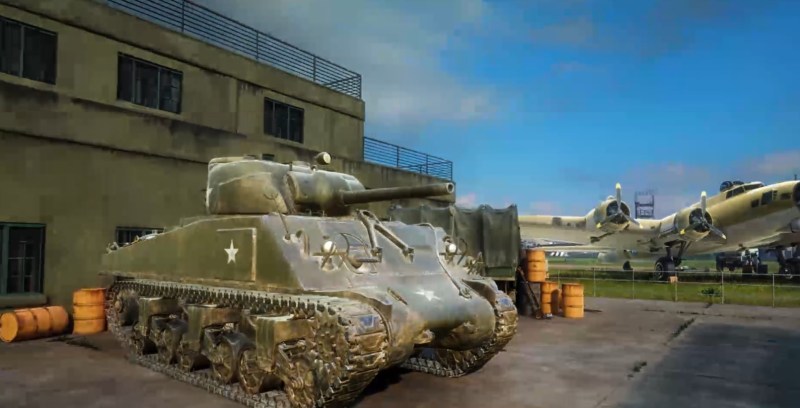
Above: You will feel what it’s like to be in a Sherman tank in Medal of Honor: Above and Beyond.
Question: When you’re crouching and ducking, you can’t just do that anywhere, right? It has to be done near cover.
Hirschmann: Well, you can do it wherever. You have a collision sphere that will interact with the environment, so you can’t duck your head into a piece of geometry. But you have complete freedom.
Question: So I can just duck or sit down or whatever at any point in the game?
Hirschmann: Absolutely, yeah.
Question: When you climb and reach the apex, it does fade to black and come back up sometimes. Is that permanent?
Hirschmann: That is a comfort thing that — when you’re climbing something and you transition to standing on it, no matter what we did, it always felt a little jarring. There was always a bit of a pop and disconnect. That quick fade down and fade up allows your brain to reorient. Honestly, in all the tests we’ve done, that has felt the best in how people react to it.
Again, we could make it a little more realistic, but it’s jarring. When you hit that point at the top mechanically, there’s just a little fade out and a little fade in, and it positions you on top of wherever you were climbing.
Question: Is it the same with the spiral staircase?
Hirschmann: [laughs] Yeah. You used to be able to go up — that was an Oculus request, for OC6, to do that. I thought it was rad! But testers felt otherwise.
Question: You mentioned the collision sphere. I noticed that when you get too close to a desk or something, your model….
Hirschmann: Yeah. That’s something we’re constantly tuning. There’s a couple of ways to fine-tune that. Leaning and looking is some of the coolest stuff, and a lot of it is just collision mesh optimization. There are also some systemic things we can do. But yeah, we’re constantly refining that.
Doran: We definitely want you to get as close to all the art as we can.
Question: Are you planning a teleportation system, or is it straight….
Hirschmann: We had one for a long time. For the first year the game existed, we had one, and there was a whole system built around it. Back then it was the thing, but also — I thought it was kind of cool. It wasn’t instant teleportation. We called it tactical traversal, if I can go down a rabbit hole here. It took into account that you weren’t magically beaming around. When you chose the next spot you were going to, the camera would go third-person and your character would navigate that space in real time to account for people shooting at you.
It was neat. The character would dynamically duck under stuff and leap over stuff. It just always — stick movement was always so much better for the experience and for the AI. We just had a moment where we decided it would be better to focus on one of these instead of splitting our attention. Believe me, we invested a lot of time in it. But I never look back on that being a bad decision. Just focusing on making the stick stuff as good as possible.
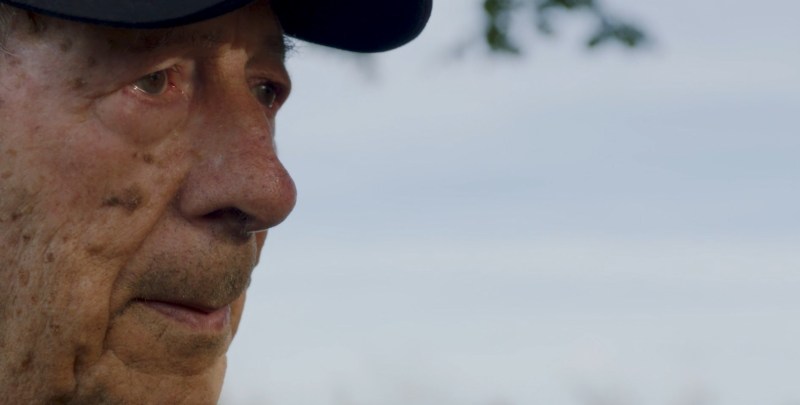
Above: Oculus and Respawn interviewed veterans for Medal of Honor: Above and Beyond’s bonus content.
Question: Back on the haptics, is that very different from the haptics in a game pad controller?
Doran: Game creators are going to have the ability to tie haptic strength and pulse lengths to whatever in-game events they want to. A big explosion going off right next to you is going to have a big haptic. Shooting a pistol, maybe a smaller one. Ejecting a clip, maybe a small one. Getting hit, maybe a medium one. In that way it’s not really any different from development on another platform.
Question: Is the haptic in the trigger, or elsewhere as well?
Doran: It’s elsewhere in the controller. It’s not built into the trigger itself. It’s more in the body of the controller.
Question: Will there be different difficulty settings? What skill levels are you aiming for?
Hirschmann: For OC6, if you go to the menu, there’s easy, medium, and hard. That’s tied to weapons right now, how much damage you take. We want to parse that out a little more. We’ll tie achievements and progress, things you unlock, to that.
We want to always be cognizant of comfort options giving the player an advantage or disadvantage. Especially for multiplayer. We have a lot of knobs to turn and levers to flip. Right now it’s the damage every weapon does, the accuracy bonus you get when you’re holding it, how much damage you can take.
For me, what I’m looking forward to, whatever we call it, is our equivalent of an Ironman setting, at least per segment, where there are no checkpoints. The mission designers have done an amazing job of allowing you to play through those levels in different ways. Not just the weapons you’re using, but the paths you take and how you approach them. If you’re being aggressive or being sneaky, you get a very different experience. More so than in any other game I’ve worked on in my career, the emergent moments you get on any given playthrough of the same segment — it’s pretty dynamic.
We didn’t have a checkpoint system, believe it or not, for a long time. When you died, you had to start the segment over. I loved it, because as you — okay, I’m going to try it a little differently this time. For me, the sign of a fun game is one where if you die, you’re not mad at the game. You’re thinking, “Okay, maybe there’s another way to do this.” Because you’re allowed to — there’s not one right way to do it. It’s not super linear. There’s not some secret where you just have to do this and then do that. You’re constantly getting to experiment and make tactical choices.
As you might imagine, I’ve seen these levels played through many times in the past couple of months. [laughs] It’s different every time. Just today, it’s been played differently.
Question: Does the AI scale as far as intelligence or awareness?
Hirschmann: We don’t want to mess with logic hooks and stuff like that. It’s more on their accuracy and the damage their weapons do. But we never want to make them dumb. There’s nothing worse than a dumb enemy.
Doran: There are so many cool things they’ll do. They’ll run up to a grenade and try to pick it up and throw it back. Or if they hear the ping from the Garand they’ll know you’re out of ammo and rush you. We want a player of any skill level to have those moments. That’s why we don’t want to take away any kind of behavior on an easier difficulty.
Hirschmann: I don’t know if you saw, but we have dynamic head tracking. An NPC, independent of their animation set, can look at stuff, which is cool. When you have two AI behind cover looking at each other, and one says something to the other, and it’s all dynamically driven, that’s a really cool moment. Those emergent things, you start seeing them. That, for me, helps define what Medal of Honor is.
We do have you riding the motorcycle, riding in the sub, flying in the plane, but the number one priority is always building the best bad guy that we can, and giving the player the payoff for that. Then when you add narrative on top of that, skits on top of that, these different settings, it starts to add up.

Above: Respawn’s mocap team was busy on Medal of Honor: Above and Beyond.
Doran: Did you talk about dynamically generated bad guys?
Hirschmann: Our tool under the hood — because it’s not a sci-fi game or a fantasy game, they’re not wearing suits of armor or stormtrooper helmets. You can see every enemy’s face. We have a rule. You never shoot the same Nazi twice. We have a whole tool set we’ve been developing for a couple of years, where when the designers place an enemy, the game procedurally generates them.
The designer has the ability — all the stuff you might expect, like uniform and kit, or even what actor plays them from a voice standpoint. But then, from a visual standpoint, it procedurally generates that face. The designer can go in and tweak any aspect of it. We tried to create a set of customization tools that are really robust. As you’re going through the level, you are fighting against the Aryans, and they’re very proud of that. But we wanted a diverse set of characters.
We can change everything from beard scruff to eye color. We have a glass eye setting, which started off as a joke, and then it got implemented. All these different hair styles. Size and silhouette, it’s all pretty robust. That was something that was very important to us. You’re not seeing an army of clones. You’re seeing individuals.
